Meet Our Young Investigators
The Skip Viragh Center for Pancreas Cancer Clinical Research and Patient Care attracts the most accomplished young investigators interested in pursuing a career in pancreatic cancer research and treatment. By training with established investigators, Skip Viragh Center fellows are helping advance the science and bringing much-needed new therapies to patients.
Hope For the Most Advanced Pancreatic Cancers
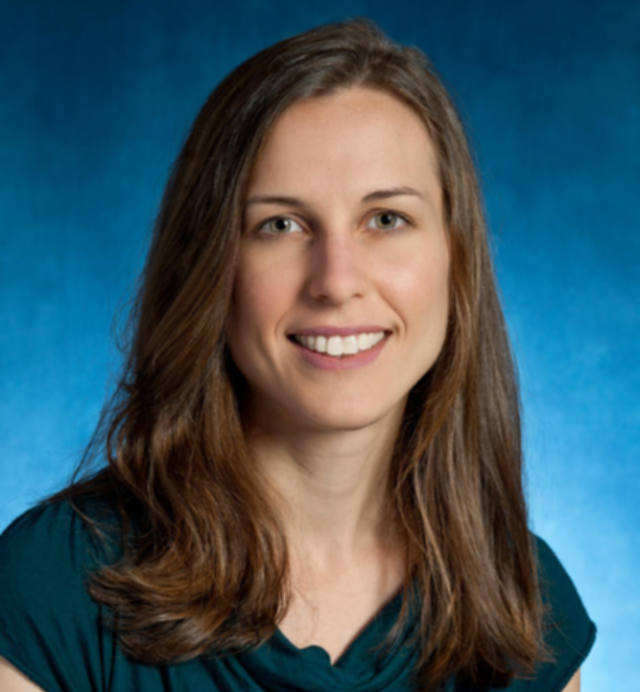 Katherine Bever
Katherine BeverCollaborating with Dung Le to bring hope to patients facing the worst form of pancreatic cancer. Bever and Le are developing clinical trials for patients with advanced pancreatic cancers that have spread outside of the pancreas. One immune therapy trial combines the pancreatic cancer vaccine GVAX to bring cancer-killing T cells to pancreatic tumors with immune checkpoint inhibitors to block PD-1 and IDO, that in many cancers act like an off-switch for T cells and shut down the immune response.
They plan to treat patients with PD-1 and IDO inhibitors and the GVAX vaccine followed by the listeria vaccine. Listeria bacteria augment the vaccine response and are engineered to express mesothelin, an immune cell-alerting antigen or tumor characteristic common to many pancreatic cancers. Bever hopes the combined approach will synergistically remove the breaks from the immune system and bring in T cells that will be specifically targeted to pancreatic cancer cells.
Immune therapy offers one of the only promising treatments for the most advanced pancreatic cancers that cannot be controlled with surgery, chemotherapy or radiation therapy.
Combining for a Cure
 Valerie Lee
Valerie LeeValerie Lee is investigating a new treatment approach that may make currently incurable pancreatic cancers curable.
Working with Jaffee, Laheru, Lei Zheng and Ella-Mae Shupe, Lee’s focus is on locally advanced pancreatic cancer. Although the cancer has not invaded other organs (metastatic), it has begun to attach itself to the tissue and vessels around the pancreas and, as a result, it cannot be treated with surgery. About 40 percent of patients diagnosed have this form of the cancer. “Right now, we don’t have many treatment options for them,” says Lee. They receive the same treatment that patients with metastatic pancreatic cancer get, she says.
Lee’s approach could make curative surgery an option for many more patients. It combines anticancer drugs, a pancreatic cancer vaccine, an exciting new type of immune therapy known as an immune checkpoint blockade and a very precise form of radiation therapy called stereotactic body radiation therapy.
The therapy uses standard anticancer drugs to stabilize the cancer, followed by the Jaffee-developed pancreatic cancer vaccine. The vaccine awakens the immune system, summoning cancer-fighting killer T cells to the tumor. Treatment with a new checkpoint blockade immune therapy known as anti-PD-1 disrupts a mechanism cancer cells use to hide from these T cells. Lee hopes that together, these therapies will cause the patient’s own immune system to attack the cancer. Patients receive two doses of this combined regimen three weeks apart.
Next, patients begin five days of radiation therapy. This treatment destroys pancreatic cancer cells and also awakens the immune system, Lee says. As cancer cells die, they release their proteins into the body. Essentially, they show their true colors to the immune system, which now recognizes them as abnormal cells; immune cells are then deployed to the tumor. Patients will then, hopefully, get surgery and chemotherapy, followed by more immunotherapy, with the goal of keeping the tumors at bay.
With funding support from the United Company Charitable Foundation and the James W. and Frances Gibson McGlothlin Foundation of Bristol, Va, the Kimmel Cancer Center will soon begin a clinical trial in 54 patients to study the combined therapy. Lee wants to see if it works well enough against the cancer to get more patients to surgery, where their cancers could be cured. At a minimum, she hopes it will keep patients’ cancers from spreading- and potentially keep them in check for a long time.
Immune Therapy Combo and Nanomedicine
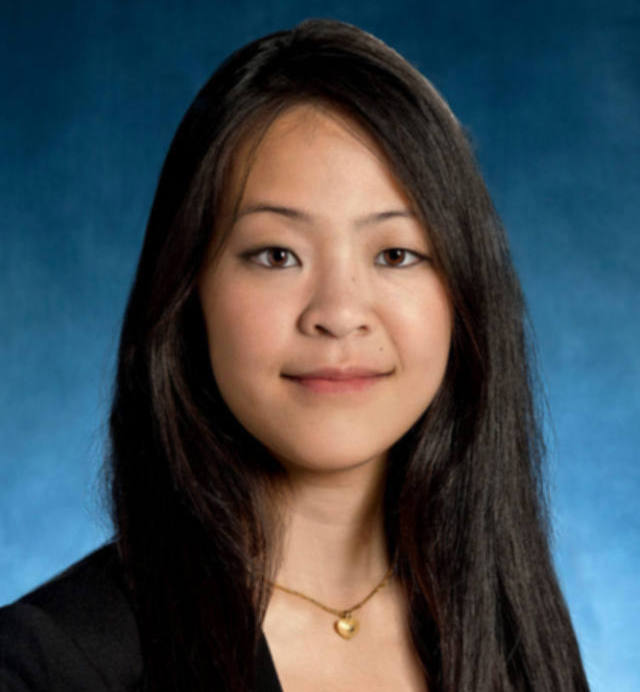 May Tun Saung
May Tun SaungMay Tun Saung is working with pancreatic cancer expert Lei Zheng to develop combination immunotherapies to improve the effectiveness of treatments. Saung is focusing on a particular type of immune cell called a macrophage. It is a large white blood cell that plays a critical role in the body’s immune response but is corrupted by cancer, switching roles to aid the tumor instead of destroying it. “Our goal is to convert macrophages from immune suppressing to immune activating,” says Saung.
In the laboratory, she is working with Zheng to explore drugs that target macrophages, in combination with GVAX and anti-PD-1 checkpoint inhibitors, to enhance the anti-tumor immune response.
She is developing a clinical trial that combines the pancreatic cancer vaccine, GVAX, anti-PD-1 immune checkpoint blockade and a macrophage-modulating agent in an effort to release the biological brakes the cancer cells places on the immune system.
Patients who have pancreatic cancers that currently cannot be successfully removed with surgery would first receive chemotherapy and radiation treatment followed by two rounds of treatment with immune therapy. Saung and Zheng hope the novel treatment approach will improve upon our current ability to knock back the tumor enough for surgical removal. Immune therapy continues after surgery to keep immune cells ignited against the cancer and to clean up any microscopic cancer cells that escape surgery.
Saung is forming collaborations with Justin Hanes, Director of the Center for Nanomedicine, and Hai-Quan Mao, Associate Director of the Institute for NanoBioTechnology, to develop nanoparticles that enhance tumor immunity. Nanoparticles are tiny nano-scale structures that are larger than molecules. In cancer medicine, they can be used to improve the effectiveness and efficiency of transporting drugs to tumors. Saung envisions nanoparticles loaded with tumor antigens to stir an immune response specifically against the cancer and immune therapy molecules on the surfaces to keep the immune response active. Precision medicine approaches are possible as patients’ tumors could be sequenced to identify the specific molecules that may provoke improved immune signals against the cancer cells. Nanoparticles could include these molecules to generate an anti-tumor response specific to a patient’s, unleashing a more potent immune response against the cancer.
Using Pathology to Improve Immune Therapies
 Liz Thompson
Liz ThompsonLiz Thompson is a new faculty member, collaborating with Skip Viragh Center co-directors Elizabeth Jaffee and Daniel Laheru, clinician-scientist Lei Zheng and pathologist Ralph Hruban. As a surgical pathologist, she is focused on deciphering and characterizing the immune response at all stages of pancreatic cancer, particularly how immune activity changes in response to different types of immune therapies. She expects this research to reveal new immune targets for therapy and biomarkers that predict whether a cancer will or will not respond to immune therapy.
Thompson will compare tumor biopsies obtained before treatment to samples taken at surgery. For pancreatic cancers that cannot be treated with surgery, she will use biopsies taken at different time points throughout diagnosis and treatment. Thompson will use advanced technologies, such as flow cytometry and DNA sequencing, to sort through and collect immune cells for study and to identify proteins that influence immune activity. In addition, a sophisticated technology known as multiplex immunohistochemistry will be used to visualize the spatial composition of immune cells within tumors.
“Cancers tend to change, mutating their DNA to survive in the face of different treatments,” says Thompson. “This work will help us better understand and target these changes to keep the immune system active as the tumor evolves.”
Her ultimate goal is to convert even the most advanced pancreatic cancers to a chronic, manageable disease.
Combinations That Make Vaccine Therapy Work Better
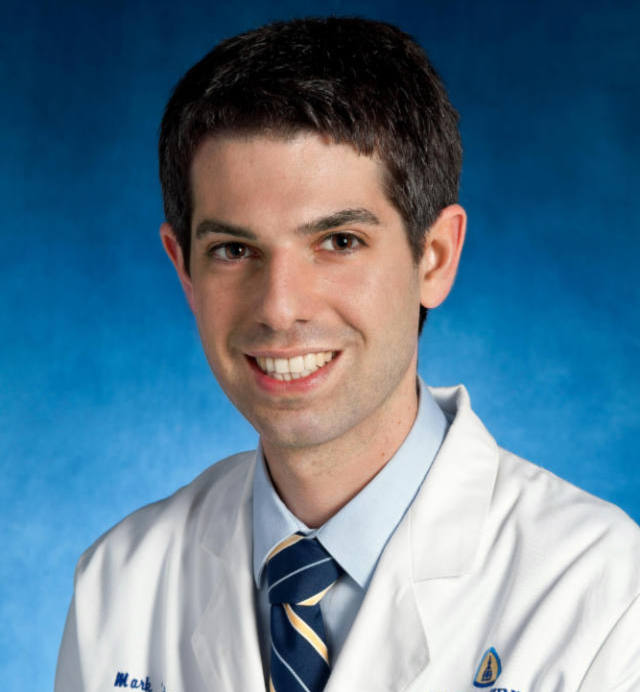 Mark Yarchoan
Mark YarchoanMark Yarchoan, the Linda Rubin Fellow, is hoping to build upon Jaffee’s work on the pancreatic cancer vaccine. He is studying whether combining additional immune therapies with the vaccine makes the killer T cells the vaccine recruits to tumors better at destroying cancer cells.
Before Jaffee and team’s pancreatic cancer vaccine, cancer-fighting immune cells were not usually found in pancreatic tumors, says Yarchoan. “I’m hoping we can push immune therapy even further by adding in additional immunotherapies that make T cells work better within the cancer,” he says.
“In melanoma, patients are more likely to respond to a combination of ipilumumab and nivolumab than if either agent is used alone,” says Yarchoan. The drugs are known as a checkpoint inhibitors for their ability to shut down a mechanism that cancer cells use to suppress an immune response. Ipilimumab targets the CTLA-4 immune checkpoint, and nivolumab targets the PD-1 checkpoint, but there are many others checkpoints that have been identified, including IDO, LAG3 and CD40, that can be targeted with other inhibitors. Yarchoan believes adding a checkpoint inhibitor to vaccine therapy might improve responses in pancreatic cancer as adding ipilumumab to nivolumab did in melanoma.
PD-1 checkpoint inhibitor therapy has been a major breakthrough at the Kimmel Cancer Center, resulting in remarkable responses in melanoma and lung cancer, and showing the potential to have benefit across essentially all cancer types. “The research is so new that no one knows what to mix the PD-1 inhibitors with at this point for pancreatic cancer,” says Yarchoan. “I want to learn how we can add in other immune checkpoint inhibitors to take advantage of the incredible T cell activation the vaccine gives us.” The first step of his research will focus on defining the best checkpoint inhibitors—or combinations of inhibitors—to add with the vaccine.
“The vaccine is the first step in turning pancreatic cancer into an immune-responsive cancer. Now that the vaccine has gotten T cells into the cancer, we need to let them do their work by removing as many blocks against the immune system as we can,” says Yarchoan.
Although still in a very early stage, he is also investigating opportunities to apply precision, or personalized, medicine to immune therapy. Yarchoan will explore whether the mechanism that prevents T cells from doing their job may vary among patients. “Potentially, we could customize what we combine the vaccine with at an individual level,” he says. His ultimate goal is to broaden and improve response rates to the pancreatic cancer vaccine.
“Breast cancer traditionally is not thought of as highly immunogenic. The same is true of pancreatic cancer, so I thought investigating breast cancer the way we research pancreatic cancer might provide leads.”
Fellows
4th Year
Making Treatments Work Better
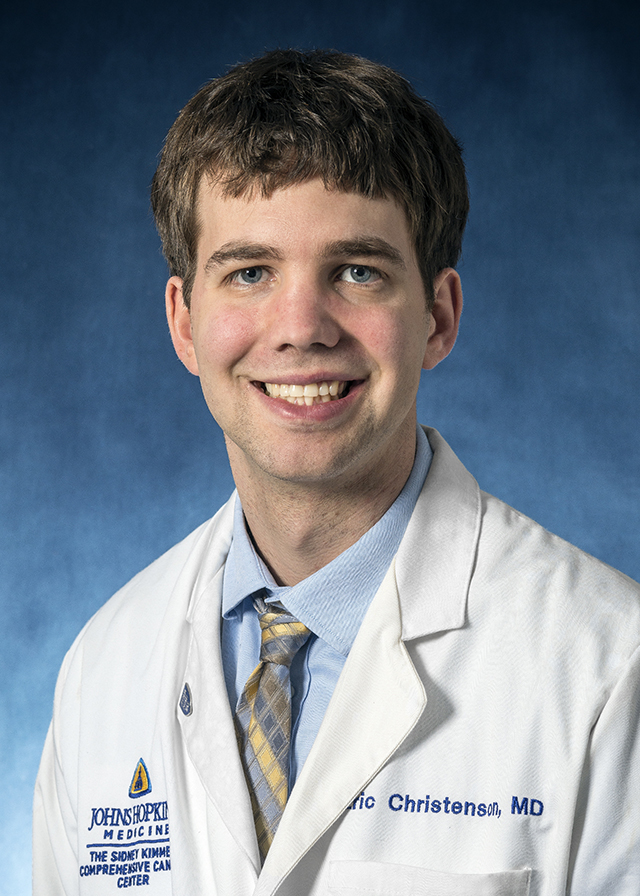 Eric Christenson, MD
Eric Christenson, MDWhen cancer cells are damaged by chemotherapy or radiation treatment, repair mechanisms are engaged to fix the damage and save the cell. Eric Christenson’s goal is to kill cancer cells by shutting down their ability to make these repairs. Blocking these repairs, he says, may have two benefits—causing cancer cells to die outright and improving response to immunotherapies. Damage to cancer cells is characterized by mutations to the cell’s DNA. Enough of these mutations make cancer cells more noticeable to the immune system. “Small numbers of mutations are bad for us and good for the cancer. A lot of mutations are bad for the cancer and good for us,” Christenson explains. His goal is to keep the cancer from walking that fine line between too few mutations and the right number of mutations by using a drug that works through a mutation-promoting pathway called APOBEC to turn repair mechanisms on and off. Laboratory studies in human cells were promising. Studies are ongoing, and Christenson says the ultimate goal is to make existing treatments work better.
Improving Immune Therapies
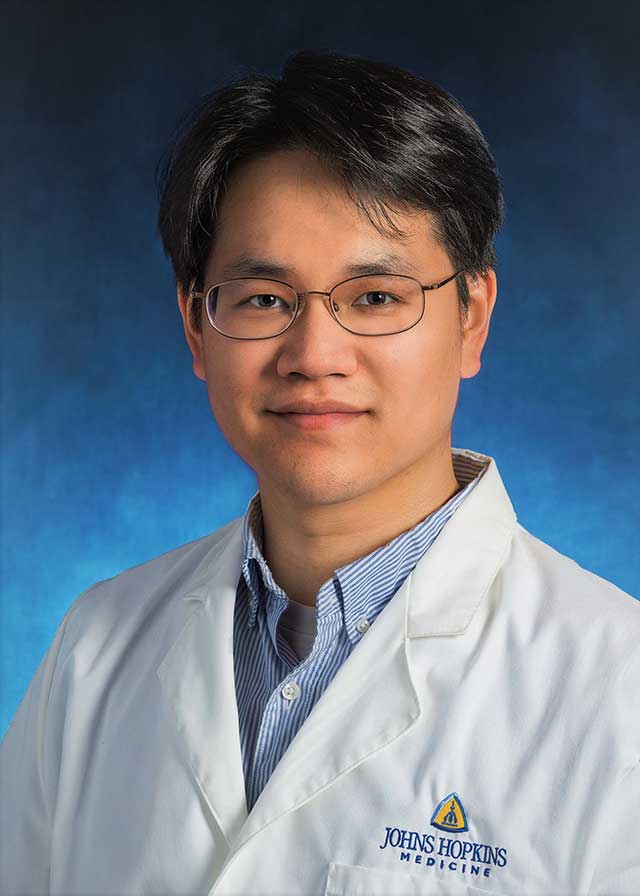 Won Jin Ho, MD
Won Jin Ho, MDWon Jin Ho is exploring a new target called PTPN22 with the aim of improving immune therapies for pancreatic cancer. PTPN22 is a protein that regulates the function of immune T cells, Jin says. People born with mutations in the gene are at higher risk for autoimmune diseases—conditions where a person’s own immune cells attack healthy organs and cells. Following this clue, Ho took a closer look at potential role the gene could be playing in cancer immunity and found that it puts the brakes on T cells, stopping these foot soldiers of the immune system from going after cancer cells. In mouse models, Ho found that when PTPN22 is blocked, an immune response to the cancer starts. Jin is working with colleagues at Purdue University on a new drug that blocks PTPN22, which he hopes to ultimately study in clinical trials.
He is also focused on new technologies that can accelerate cancer biomarker discoveries. For example, using a technology known as mass cytometry that provides data on more than 40 characteristics of cells, Ho is helping Dung Le, Katie Bever and Elizabeth Jaffee evaluate immunotherapies for pancreatic cancer. He is performing immune profiles of tissue and blood obtained from patients before and during treatment with a variety of immunotherapies to monitor how the immune system responds. His goal is to identify biomarkers that can tell if an immunotherapy is working and to predict patients most likely to benefit.
3rd Year
Approaching Treatment from the Patient Perspective
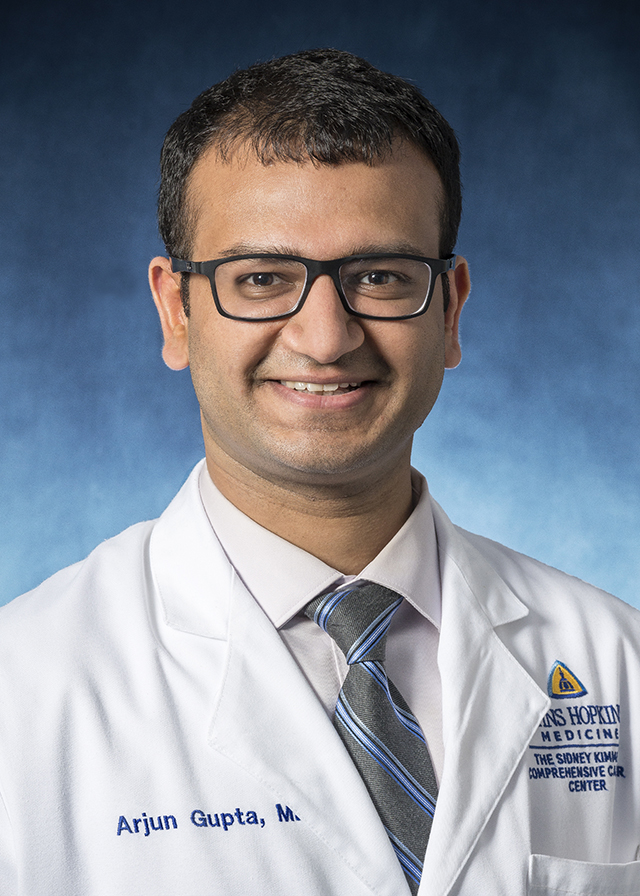 Arjun Gupta, MD
Arjun Gupta, MDArjun Gupta takes a different research approach to advancing clinical care. Rather than studying new treatments in the laboratory, he studies patient access to therapy, hidden costs rarely considered and burdens that impact patient quality of life during treatment and beyond. He is exploring ways to reduce the harm caused by what he calls “financial toxicities,” including added out of pocket costs. For example, he says, a month’s supply of pancreatic enzyme replacement therapy, to replace essential digestive enzymes the pancreas cannot make on its own after cancer therapy, can cost $1000. Parking fees during the course of treatment can total hundreds of dollars. In a study of patients receiving radiation therapy to relieve pain caused by cancers that spread to the bone, Gupta found that many patients received 20 treatments, but the same pain control was achievable with just one treatment. The added expense and inconvenience of travel and time spent in waiting rooms are among the burdens that therapies and overuse of therapies place on patients, Gupta says. A clinical study he is leading in collaboration with Vikesh Singh, director of the pancreatitis center, is aimed at pain management without the undesirable side effects caused by opioids or invasive procedures, like nerve blocks. The study explores a drug commonly used to treat the kind of nerve pain often caused by pancreas cancer and includes quantitative sensory testing to assess nerve damage and response to the drug.
Finally, Gupta is focused on making sure patients have an opportunity to make fully informed treatment decisions. When given the choice, he says, patients overwhelmingly prefer to be at home than in the hospital. Some therapies may extend survival by a few months, but that time is often spent in rehabilitation or other care facilities and not at home. Gupta says he wants to make sure patients have all of the information they need to choose care that matches their goals.
Immunotherapy Studied in Aggressive Pancreatic Cancer Subtype
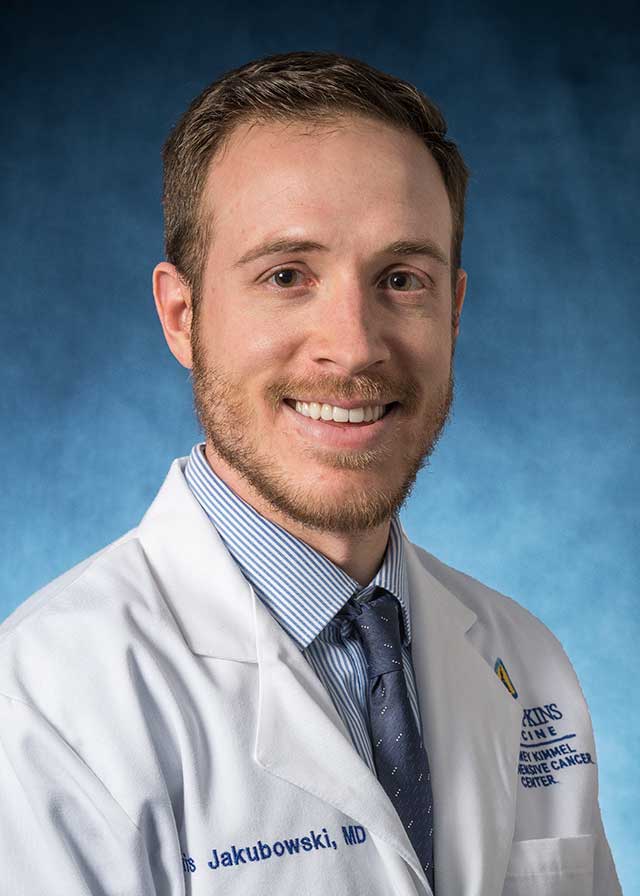 Chris Jakubowski, MD
Chris Jakubowski, MDClinical trials of immunotherapy are planned for a rare and aggressive type of pancreatic cancer, known as adenosquamous cell. Because it accounts for less than 5% of pancreatic cancers, it is poorly understood and has no clinical studies. Standard therapies are currently the only options for patients, who often have poor responses. Taking a closer look at the little studied cancer, pathologist Liz Thompson, M.D., found higher immune checkpoint expression and more cancer-killing T cells in the cancer than is typically found in pancreatic cancer. Immune checkpoints provide stop and go signals to the immune system. Cancer cells use them to shut down immune responses to cancer. Based on these findings, Christopher Jakubowski is working with pancreatic cancer experts Nilo Azad, M.D., Daniel Laheru, M.D., and Elizabeth Jaffee, M.D., to develop a clinical trial of anti-PD-1 immunotherapy—a drug treatment that removes restraints cancer cells place on immune cells—for patients with advanced adenosquamous pancreatic cancer. Since the cancer is so rare, Jakubowski is collaborating with the Mayo Clinic to reach enough patients to conduct a clinical study. Biopsies will be taken before and after treatment to advance laboratory research and gain a better understanding of the cancer. Part of what they hope to learn is what causes the cancer to have its squamous cell component—one of the characteristics that make it less responsive to standard treatments— and what leads to the more favorable immune environment. What they learn, Jakubowski says, could help adenosquamous cell patients and provide new insights that could also help make immunotherapy work better in this cancer and more common types of pancreatic cancer.
Arsen Ospov, a Linda Rubin fellow, is focused on uncovering ways to modify the microscopic environment around tumors to make immunotherapies work better against pancreatic cancer. He is looking closely at the focal adhesion kinase (FAK), which contributes to cell spreading and migration. He wants to explore the effect inhibiting this protein has on immune cells around the tumor. Ospov is the first to look at the role of FAK in sensitizing pancreas cancer to immunotherapy and radiation therapy, finding in mouse models that a combining a FAK inhibitor with radiation therapy increase CD8 immune T cells, which are naturally part of the “off” signal to immune responses. As a result, he began a clinical trial comparing treatment with the anti-PD-1 immune checkpoint blocking drug pembrolizumab alone with a combination of a FAK inhibitor and pembrolizumab following chemotherapy in patients who are candidates for surgery. Biopsies are obtained before and after treatment to evaluate the impact of the FAK/pembro combination and pembrolizumab alone.
New Ways to Intercept Cancer
 Jackie Zimmerman, MD, PhD
Jackie Zimmerman, MD, PhDJackie Zimmerman is among an increasing number of cancer researchers who are taking a closer look at microRNAs and how blocking them with drugs could stop or slow cancer formation, extend survival or even be biomarkers that mark new cancers early before they can be detected through imaging. She explains that although, microRNAs do not impact cancer through direct mutations, they function to regulate gene expression, which results in tumor suppressive or, conversely, tumor growth supportive activities. Using organoids—tiny 3D representations of human organs derived from tumor tissue removed in surgical biopsies and treatments—Zimmerman is studying the potential of drugs that block microRNAs to intercept cancers and stop them in their tracks.
2nd Year
Aging and the Microenvironment
 Daniel Zabransky, MD, PhD
Daniel Zabransky, MD, PhDHow can aging affect the microenvironment of pancreatic cancers? That’s what Daniel Zabransky is looking to find out.
Working with oncology experts Elizabeth Jaffee, M.D., and Ashani Weeraratna, Ph.D., Zabransky is evaluating the effects of aging on gene and protein expression, and signaling activation, in the pancreatic cancer tumor microenvironment (TME), hoping to discover new pathways and molecular mechanisms that can be targeted for the treatment of pancreatic cancer.
“One thing we know from studies in melanoma is that the age of the cells in the TME, and the age of the patient, seems to really affect how they behave and how the tumor then responds,” Zabransky says. “The goal of the project is to look at both younger and older patients and see how the ages of the cells in those microenvironments affect tumor growth and spread. We think there are some differences in the way that they express genes or things that they secrete that change how the cancer cells grow and the immune system response to cancer. If we can find new pathways based on age, we potentially can come up with new treatment strategies that can be better tailored to patients based on what actually is going on in their bodies.”
Aging drastically affects non-malignant cells, particularly fibroblasts and immune cells in the TME, he says. In laboratory studies, Zabransky will study young and older mouse models of pancreatic cancer, examining the effects of an aged TME on pancreatic cancer growth and metastasis. He also will identify changes in gene and protein expression patterns in an aged pancreatic cancer TME, using the mouse models and primary tumor and stromal tissue samples from younger and older pancreatic cancer patients. He will then profile the immune cell populations found in the aged versus young pancreatic cancer TME.
Seeking Novel Immunotherapy Treatments
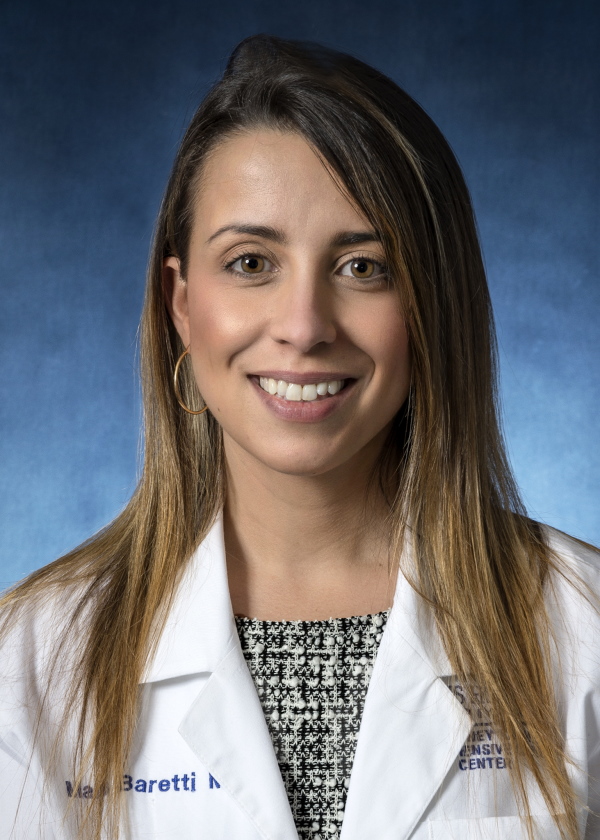 Marina Baretti, MD
Marina Baretti, MDA native of Italy, Marina Baretti believes her destiny is to pursue clinical translational cancer research on a global scale. At Johns Hopkins, she has been working with pancreatic cancer experts Elizabeth Jaffee, M.D., and Nilofer Azad, M.D., on projects trying to better understand the tumor microenvironment of pancreatic cancers and look for novel immunotherapy treatments.
“Pancreatic cancer is one of the most aggressive cancers, with limited treatment options,” Baretti says. Immune checkpoint therapy and inhibitors have shown good results in some cancers but in pancreatic cancers, the response has been very modest, she says. “The effort in my research is really focused on trying to overcome the ineffectiveness of immune checkpoint inhibitors and produce new treatments for pancreatic cancer patients.”
In the lab, Baretti has been exploring the effects of a histone deacetylase (HDAC) inhibitor called entinostat. This is an epigenetic drug that controls gene expression without changing the primary sequence of nucleotides in the DNA sequence. In a mouse model of pancreatic cancer, animals given the drug had an increase in the infiltration of immune system T cells and a decrease in the number and function of immune suppressive cells. When given the drug together with a checkpoint inhibitor, the mice had a significant improvement in survival and delay in tumor growth.
Clinically, Baretti directed the first phase II study of combination epigenetic therapy and immunotherapy in patients with advanced pancreatic cancers who failed standard chemotherapy. She is analyzing results to look for any biomarkers to predict which patients can respond to the combination therapy, and why, as well as why other patient may not respond, and what can be done to make their cancers more sensitive to the treatment.
Parul Agarwal, MD
Thatcher Heumann, MD, MPH
